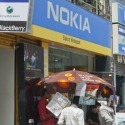
With a spectrum auction looming and mobile data services flourishing, Nokia Networks is confident of growth in India this year.
But even as 4G deployments increase, 3G will continue to be the main technology for mobile broadband in the country, according to Sandeep Girotra, the head of the India region for Nokia Networks .
"3G is going to be the primary vehicle for mobile broadband in India and we will see selective deployment of 4G this year," he says. "This is mainly because the coverage and ecosystem is better developed for 3G."
Reliance Jio is planning to launch 4G services later this year. Bharti Airtel Ltd. (Mumbai: BHARTIARTL) has already launched 4G in a few circles of Bengaluru, Chandigarh, Kolkata and Pune and aims to launch 4G services in Delhi soon.
Indian service providers have been recording a significant increase in data usage over the last few quarters. Bharti Airtel, the country's biggest operator, recently reported that 22.6% of its revenue was coming from non-voice services in the October-to-December quarter. In the same quarter, Vodafone India reported 40% growth in average data usage per customer.
However, this growth comes with challenges for Indian operators. "Mobile broadband is finally becoming a reality in India," says Girotra. "With this trend more and more spectrum would be needed because we are just witnessing the start of data growth. The Indian market will face spectrum and capacity challenges ahead."
For all the latest news from the wireless networking and services sector, check out our dedicated mobile content channel here on Light Reading.
The country is holding a multi-band spectrum auction next month to address these challenges. Coupled with positive regulatory changes, that bodes well for the likes of Nokia.
The auction of 1800MHz will be of particular interest to the vendors. Operators such as Vodafone and Idea Cellular Ltd. -- which lack Broadband Wireless Access spectrum -- are likely to use these airwaves to support the rollout of FDD-LTE technology, allowing them to offer high-speed 4G connectivity to their customers. (See Spectrum Pricing Provokes Jitters in India and India Targets $10.3B From Spectrum Auctions.)
"The [forthcoming] auction of 1800MHz is going to be important from the deployment of LTE perspective," says Girotra. "Besides that we are continuously interacting with the service providers to enable them to reduce opex and to help them in their journey from 2G to 3G to 4G."
After a downturn that lasted from 2012 until mid-2014, India's telecom market has shown signs of a revival in the last six months.
Nokia claims to have signed 34 operator deals last year, including a multi-year agreement with Vodafone covering 19 circles (service areas) as part of the operator's Project Spring investment program.
Nokia has also captured a significant share of 3G expansion deals and last month announced India's first LTE-FDD deal with Bharti Airtel, covering six circles.
Even so, with rivals like Ericsson AB (Nasdaq: ERIC) and Huawei Technologies Co. Ltd. also looking to grow their share of the Indian pie, it will have to be on its guard.
— Gagandeep Kaur, contributing editor, special to Light Reading
About the Author(s)
You May Also Like




.jpg?width=300&auto=webp&quality=80&disable=upscale)







